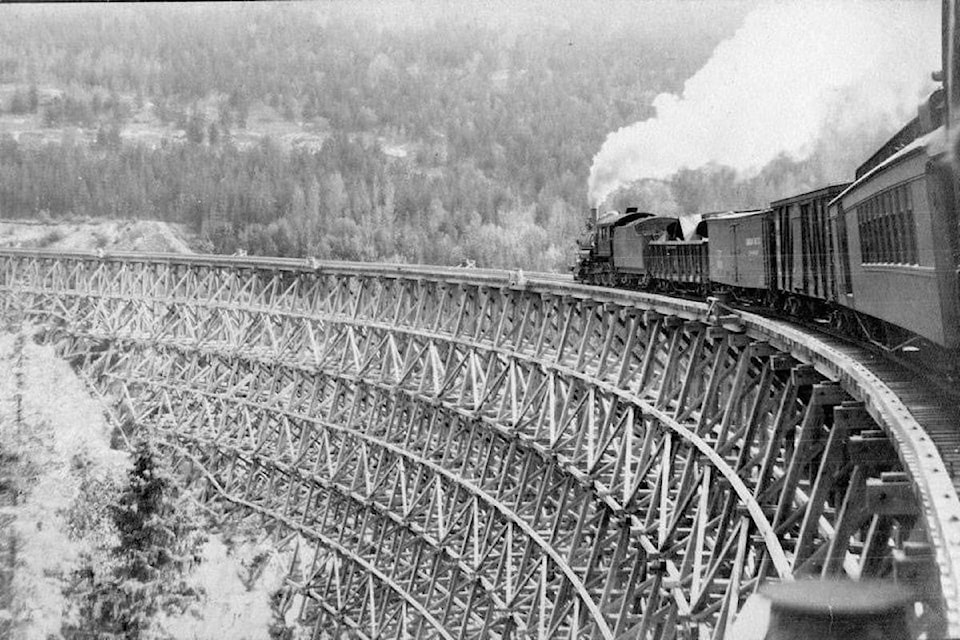The mineral wealth of the Boundary Country seemed limitless as the 20th century dawned. The region between the Kootenays and the Okanagan was the largest mineral producer in British Columbia. Every small town newspaper trumpeted its community’s bright economic prospects.
Railroad charters were granted by the province liberally. Most recipients were start-ups, rather than established railroads. And most often these charters failed to gain financial support and were never built. They were “paper railroads”. A Grand Forks charter was one of the exceptions.
Tracy Holland, a newcomer to Grand Forks in 1900, noted the steady passage of railcars down the CPR’s track from the Phoenix mine to the smelter at Grand Forks. He realized the town of Republic, just across the American border, presented an opportunity. It had viable mines and no rail service. He and his investors obtained a provincial charter for the Grand Forks & Kettle River Railway.
In 1901, the nascent railway broadened its ambitions, proposing three branch lines, including a line to the Franklin mining camp. The federal government granted the charter under the name of the Kettle River Valley Railway. By then, the townspeople, impatient with construction delays, had creatively dubbed the railway the “Hot Air Line” and the first well-worn locomotive the “Tin Whistle”.
The founder of the Minnesota-based Great Northern Railway, James J. Hill, was a Canadian. By 1890, the GNR was the dominant railway in the American Midwest and Pacific Northwest. Hill became known as “the empire builder”, deservedly so. His next target was southern B.C.
Daniel Corbin completed the Nelson and Fort Sheppard Railway in 1893 and the Columbia and Red Mountain Railway (serving Rossland) in 1896. These lines linked with Corbin’s Spokane Falls and Northern Railway. In 1899, Hill wrested control of these railways from Corbin, and consolidated them into the GNR.
Hill watched the new KRVR. He resolved to build his own line to Republic. The race to get the first line to Republic became a fierce legal battle. Worse, the rival lines did not hesitate to break the law or resort to physical conflict when required. It turned out that Holland and the tiny KRVR-R&KR – the charter in the United States was the Republic and Kettle River Railway – could litigate and rumble just as well as their much larger rival.
Construction of the KRVR line south to Republic began in October, 1901. As it progressed, the GNR line was not far behind. Holland secured an injunction to stop GNR construction. Hill responded with an injunction to prevent the R&KR from crossing his rail line. Holland had his men bridge over it. Hill sent a crew to pull down the unfinished bridge when the R&KR crew were not present. The R&KR crew rushed to the scene. A short battle ensued, and the Americans retreated.
The KRVR-R&KR completed their line first, but was a worthless victory. The GNR had the injunction on construction overturned, and followed. Hill set his freight rates at a fraction of the market rate. Holland was forced to implement competitive rates, creating a huge hole in the line’s revenue.
The GNR then installed a diamond crossing on the KRVR line in Grand Forks, despite an injunction prohibiting it. The KRVR placed a locomotive directly over the diamond, preventing the GNR from crossing. Hill threatened to reignite the crossing dispute on the Republic line. Holland responded atypically. He conceded. He ordered the locomotive be moved.
Holland fought valiantly, but tired of the pressure, he resigned his position in 1902. The leadership of the struggling railway consolidated all of its charters into Kettle Valley Lines, and attempted to finance construction to Franklin Camp. It appeared they would succeed, until Hill announced that he too would build to Franklin. He did not. He was likely only seeking to undermine KVL’s project.
To counter this, KVL proposed to extend the Franklin line north to Vernon and west across the Nicola Plateau to meet the planned CPR line at Quilchena. The Boundary’s three smelters needed Nicola coal, and the line would improve access to the coast from the Boundary and Okanagan. The proposal was sound, but didn’t attract additional finance. KVL completed only 18 of the 50 miles to Franklin Camp before exhausting its funds.
KVL had changed its proposed routes and destinations several times in an effort to procure a stable revenue stream. In 1907, it radically shifted course, launching the Spokane and British Columbia Railroad. Hill swamped the venture in litigation. This gambit, too, failed. Finally, Hill’s predatory freight rates rendered KVL’s Republic line unviable. KVL shut it down. Kettle Valley Lines risked collapse.
One last chance, in Part 2.
____
Bruce Uzelman, based in Kelowna, holds interests in British Columbia history as wells as current political and economic issues.
Bruce had a career in small business, primarily restaurant and retail. He holds a Bachelor of Arts, Advanced from the University of Saskatchewan, with Majors in Political Science and Economics.
Contact: urban.general@outlook.com

